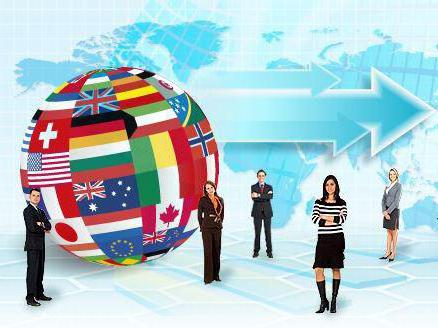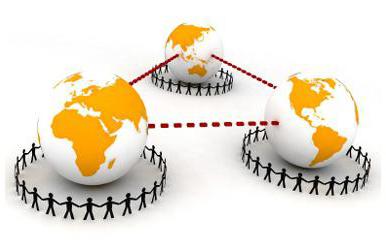For any state, the economy of foreign trade is of great importance. No country has yet succeeded in forming its own healthy economic system without participating in world trade. Let us further consider what external (international) trade is. 
General information
The development of foreign trade began long before the formation of the world economic system. Commodity exchange between the countries created the conditions for the formation of machine production, which in many cases could expand only on the basis of massive foreign demand and imported raw materials. Foreign trade acts simultaneously as a prerequisite and consequence of the world division of labor. She is the most important factor in the creation and functioning of the international economy. Its historical path began from single transactions. Over time, trade relations have developed, developing into large-scale long-term international cooperation.
Theoretical aspect
The problems of foreign trade were studied by politicians and scientists at a time when other areas of science were not sufficiently developed. From the 16th to the 18th century there was a doctrine of mercantilism. At that time, the world division of labor was limited mainly by bilateral and tripartite agreements. According to mercantilists, the state should sell as many products as possible on the foreign market, and purchase as few goods as possible. However, if all countries follow this idea, then foreign trade will be absurd.

Advantage principle
The author of this theory was Smith. His idea was based on the "profitability" of domestic production and sales of products to other countries in which output is fraught with high costs. The principle of comparative advantage is based on differences in the time spent on manufacturing one product.
Theory of Comparative Costs
In general, foreign trade acts as a means by which states can develop specialization, increase the productivity of their own resources, thus increasing their total production volume. Due to this, sovereign countries, as well as their individual regions and enterprises, can win on products that they can produce with relatively high efficiency, as well as their subsequent exchange for goods that they cannot manufacture themselves. The most important effect of rising costs is the formation of the boundaries of specialization. In this regard, often goods produced by the country's own enterprises directly compete with similar or the same imported products.

Free turnover
Thanks to trade, based on the principle of comparative costs, the world economic system can achieve a more rational allocation of resources and a high degree of material well-being. The level at which the technological knowledge of states is located and the structure of their reserves are different. From this it follows that each country should produce those products whose production costs in it are lower relative to others. If states do this, then the world can take full advantage of geographical specialization. As a side benefit of free trade is the promotion of competition and restriction of monopoly. The high productivity of foreign enterprises forces many local companies to switch to technology at lower costs.In addition, this forces firms to innovate and monitor technological progress, improving the quality of products, using scientific achievements and developments, and investing in research.
The current state of the institute
Currently, the active participation of countries in international trade is due to a number of factors. First of all, cooperation at the world level allows using the resources available in states more efficiently. Foreign trade promotes familiarization with the world achievements of technology and science. Participation in world trade allows to reduce the time for structural adjustment of the country's economic system, to more fully and fully meet the needs of the population. These opportunities and prospects, in turn, contribute to increasing interest in the mechanism by which the regulation of foreign trade is ensured. This problem is of particular importance for countries that have embarked on the formation of a market system aimed at participating in world cooperation.

Foreign trade dynamics
World trade turnover acts as a central link in a complex system of intergovernmental relations. It is a complex of foreign trade of states. Its volume, therefore, is determined by summing up the export performance of each country. Under the influence of scientific and technological progress, various structural changes are taking place in world trade, industrial production is cooperating and specializing. All this strengthens the interconnections of national economies. The volume of world trade is growing faster than production. This is proved by foreign trade statistics. So, for every 10% increase in global production, 16% of the turnover is accounted for. Foreign trade, thus, forms the prerequisites for the development of industry. Along with this, in case of interruptions in trade, production rates slow down.
Foreign trade restrictions
Experts put forward many arguments in favor of free trade. However, despite their persuasiveness, in practice many barriers are formed. The main restrictions include:
- duties (protectionist including);
- import quotas;
- non-tariff barriers.
These obstacles act as a means of implementing protectionism in the world trade. Let's consider them separately.

Tolls
These excise taxes on imported products are introduced for profit by the state or to ensure the protection of domestic producers. Fiscal duties are usually used in relation to products that are not produced at the enterprises of the country. For example, for the United States, such products are bananas, coffee, and so on. Rates of such duties are usually low. Their main goal is to ensure tax revenues to the federal budget.
Protectionist duties
They are introduced to protect the local manufacturer from foreign competitors. The amount of protectionist duties does not allow to completely stop the import of foreign products. However, such taxes put foreign producers at a very disadvantage in the process of their trading activities in domestic markets.
Import quotas
With their help, the maximum volume of a product is established that can be imported into the domestic market for a certain period of time. Often, import quotas are a more effective tool through which foreign trade is restrained than duties. Despite the high tax, certain products can be imported in relatively large quantities. But at the same time, a low import quota completely prohibits the supply of goods in excess of the established volume.
Non-tariff barriers
They should be understood as a licensing system, the creation of unjustified standards and norms of product quality, its safety, or simply bureaucratic restrictions in customs procedures.For example, Japan and a number of European countries require importers to obtain permits. By limiting the issuance of a license, imports can be effectively contained.
Safeguard Analysis
An assessment of supply and demand shows that protectionist policies lead to higher prices and lower volumes of duties. In this regard, the sale of foreign goods is significantly reduced, and local producers profit by rising prices and increasing sales volume. Fees thus lead to a less efficient allocation of global and domestic resources. In some cases, the most convincing arguments in favor of protectionist policies are references to the need to expand the defense industries and the underdevelopment of the industrial sector. Most of the remaining arguments are emotional appeals, half-truths, or false statements, emphasizing, as a rule, the immediate effect of imposing restrictions, ignoring the long-term consequences.
The state of the domestic institute at the beginning of the century
The foreign trade of Russia at the beginning of the century was very active. So, in 2003, it remained an intensively developing sector, stimulating economic and social activities within the country. Due to a combination of a number of favorable factors, Russia's foreign trade at the beginning of the century was characterized by high growth rates. Moreover, after a two-year hiatus, export indicators in dollar terms began to exceed import ones. So, in 2003, the turnover of the Russian Federation was 210.8 billion dollars. This is a quarter more than in the previous year, 2002. In December 2003, foreign trade turnover reached a record high for 15 years - $ 22.3 billion. Export growth was based on extremely favorable indicators of oil prices and other energy carriers. In the next year, 2004, market conditions preserved. In January, exports totaled $ 11 billion.

Analysis of the state of trade in 2015
At the beginning of the year, there was a sharp drop in the ruble and oil prices, the introduction of new sanctions by foreign countries. The foreign trade of the Russian Federation suffered from this. The decrease in turnover was felt by ordinary consumers. As of January 2015, the volume amounted to 38 billion rubles, decreasing by 34%. Exports decreased by 29% and imports by 41%. Such recessions are primarily due to the low exchange rate of the national currency. Statistical authorities estimated that the value of exported products decreased by 6.3%, and of imported products - by 7.2%. The price per barrel of oil fell to $ 47. This figure is comparable to the crisis indicators of 2008. In addition, according to the Ministry of Economic Development, there was a significant decline investment in construction fixed capital, the pace has decreased manufacturing industry. This, in turn, had an impact on the volume of output of goods, imports and exports.
Thus, foreign trade indicators for January 2015 were the lowest over the last 4 years. Significantly decreased the volume of purchases of equipment and machinery, goods of the chemical and metallurgical industries. Decrease in indicators was also noted during 2014. It intensified by the fall in connection with the introduction of sanctions against the Russian Federation. Investments and the provision of loans to domestic companies by foreign financial organizations decreased significantly. In addition, some sanctions have affected the import and export of products from a number of countries. A decrease in import indicators was also affected by the introduction of a food embargo by Russia.









